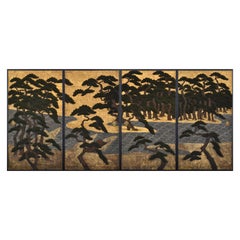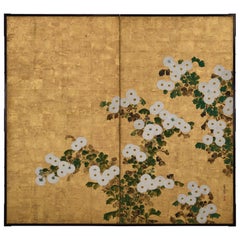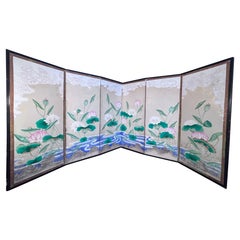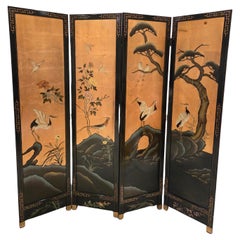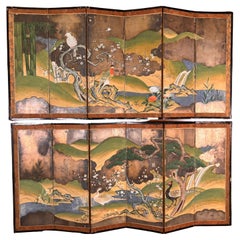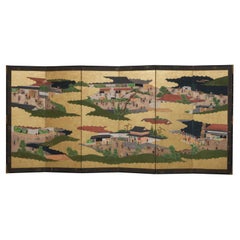Japanese Paintings and Screens
to
125
482
199
868
32
10
8
1
124
359
385
32
180
76
23
25
3
24
10
1
5
14
11
3
487
476
431
329
326
1,586
1,420
900
462
140
900
897
898
30
3
2
2
1
Place of Origin: Japanese
Circa 1700 Japanese Sliding Door (Fusuma) Set. Pine Trees on the Seashore.
Located in Kyoto, JP
"Pine Trees on the Seashore"
A set of four sliding doors (Japanese fusuma). Ink, color, gold-leaf and gold-fleck on paper.
Dimensions (total display si...
Category
Late 17th Century Edo Antique Japanese Paintings and Screens
Materials
Gold Leaf
18th Century Japanese Rinpa Screen. White Chrysanthemums. School of Korin.
Located in Kyoto, JP
School of Ogata Korin
White Chrysanthemums
18th Century, Edo period.
A two-panel Japanese screen. Ink, color, gofun and gold leaf on paper.
Dimensions: H. 171 cm x W. 188 cm (67.5” x 74”)
On this two-panel Japanese screen we see blooming chrysanthemums, a flower which embodies the essence of autumn in Japan. Here the traditional floral theme has been simplified and stylized. The bright colors and asymmetrical composition against the delicate gold leaf create a luxurious and ornate work of art. Its background, a strikingly patinated grid of gold leaf, denies any sense of place or time and imbues everything with an ethereal glow. The leaves and stems of the plants are nothing more than pools of mottled color and ink without any outline whatsoever. These are typical Rinpa adaptations of traditional ink painting methods; tarashikomi, or diluted washes of color blended while very wet, and mokkotsu, or “bonelessness,” which creates forms without exterior outlines. The relief work of the rounded flower petals has been obtained by the moriage process (a mixture based on ground shells modeled on the surface of the paper).
On the lower right of the screen, the siganture “Hokyo Korin Jakumyo” and the “Hoshuku” seal can be read. Korin is Ogata Korin, famed for the Irises (Nezu Museum) and Red and White Plum Blossom (MOA Museum of Art) folding screens, both National Treasures. Korin worked in both Kyoto and Edo in the mid-Edo period. Korin was using the art name “Jakumyo” just after he received the Hokyo level, which was in 1701.
This particular screen was published in May of 1961 in the Japanese Sansai Fine Art Magazine*. An in depth article accompanies the photograph of the screen and and a photograph of the signature and seal. This article devotes much of its body to discussing the moriage technique, how it enlivens the chrysanthemum flowers and Korin’s specific skill in using the technique. The article goes on to discuss the most famous works of Korin, utilizing this technique, which were known at the time. Specifically a two-panel screen held in the Honolulu Museum which was discovered in the store-house of Takahashi Soan. A two-panel screen pair which the Nakano family own. A two-panel screen pair with chrysanthemums in moriage in fan designs owned by the Nomura family. Also a small folding screen featuring chrysanthemums held in the Yamato Bunkakan. The article goes on to say that this particular two-fold screen came from the Nijo family. Korin is known to have had a strong connection with the aristocratic Nijo family. The article explains that Korin received a lot of favors from the Nijo family and that this screen would have been gifted to them.
Since that time the Honolulu screen has been amended to ‘attributed to Ogata Korin’ and I do not know further details of the other 3 screens. Other Chrysanthemum screens...
Category
18th Century Edo Antique Japanese Paintings and Screens
Materials
Gold Leaf
Japanese Antique Hand Painted Lotus And Blue Waters Screen Vibrant Colors
Located in South Burlington, VT
From our recent Japanese Acquisitions- Hard to Find Lotus Flowers
A stunning Japanese Antique Hand Painted six panel byobu screen on silk executed with lovely lotus flowers and vib...
Category
19th Century Meiji Antique Japanese Paintings and Screens
Materials
Gold Leaf
Hand Painted, 4 Panel Folding Screen with Crane Birds, Room Divider
Located in Waasmunster, BE
Hand Painted, 4 Panel Folding Screen with Crane Birds, Room Divider
Category
1970s Japonisme Vintage Japanese Paintings and Screens
Materials
Gold Leaf
Japanese Rare Antique Pair Hand Painted Birds And Blue Waters Wedding screens
Located in South Burlington, VT
A lovely antique pair (2) Japanese hand-painted six-panel folding screens byobu- each conceived in an attractive birds, trees, and blue waters motif. Likely given as a wedding gift...
Category
19th Century Meiji Antique Japanese Paintings and Screens
Materials
Wood, Paper
Large Japanese 6-panel byôbu 屏風 (folding screen) with Edo genre painting
Located in Amsterdam, NL
An elaborate, large six-panel byôbu (folding screen) featuring a detailed genre painting on gold leaf, capturing the vibrancy of festive scenes from the Edo period.
Central to the p...
Category
Early 19th Century Antique Japanese Paintings and Screens
Materials
Metal, Gold Leaf
Japanese Showa Four Panel Screen Prunus with Songbirds
Located in Rio Vista, CA
Spectacular late 20th century Japanese Showa period four panel byobu screen depicting blossoming spring prunus or plum trees with songbirds in flight. The screen features a dramatic ...
Category
20th Century Showa Japanese Paintings and Screens
Materials
Brass
Early 20th Century Japanese Nihonga Screen. Bamboo Forest.
Located in Kyoto, JP
Anonymous
Bamboo Forest
Early Taisho era. Circa 1910-1915.
Six-panel Japanese Screen. Mineral pigment, gofun and ink on silk.
A six-panel Japanese folding screen, painted on silk in...
Category
Early 20th Century Taisho Japanese Paintings and Screens
Materials
Silk
Mid 19th Century Japanese Screen Pair. Flowers & Birds of the Four Seasons.
Located in Kyoto, JP
Shioka Sorin (1781-1850)
Flowers & Birds of the Four Seasons
Pair of six-panel Japanese Screens. Ink, gofun and pigments on silk.
Dimensions (each screen): H. 91.5cm x W. 285cm (3...
Category
Mid-19th Century Edo Antique Japanese Paintings and Screens
Materials
Silk
Japanese Screen Gold Leaf - Byobu Gold Leaf
By Japanese Studio
Located in Brescia, IT
Antique Japanese four-panel screen from the Kano school: landscape with beautiful and elegant cranes near the river, bamboo.
Hand painted with mineral pigments and inks on vegetable ...
Category
Early 18th Century Edo Antique Japanese Paintings and Screens
Materials
Gold Leaf
Circa 1920 Japanese Screen. Cat & Mouse Harvest Scene on Gold Silk.
Located in Kyoto, JP
The narrative playfulness of the scene depicted on this Japanese screen sets alight what is at its core a celebration of a bountiful harvest. The screen offers a visual representatio...
Category
Early 20th Century Taisho Japanese Paintings and Screens
Materials
Gold
Early 20th Century Japanese Cherry Blossom Screen by Kano Sanrakuki
Located in Kyoto, JP
Cherry Blossoms
Kano Sanrakuki (1898-1981)
Showa period, circa 1930
2-panel Japanese Screen
Color, gofun and gold leaf on paper
Against a backdrop of gold-leafed ground, the lichen covered trunk and branches of the life-sized cherry blossom tree reach out and beyond the confines of the pictorial surface. The overall composition has a feeling of flatness which draws emphasis to the surface and the three-dimensionality of the cherry blossoms. Painstakingly built-up layers of thickly applied shell-white gofun detail the voluminous blossoms and cover large areas of this tour-de-force of Japanese Nihonga painting. By simplifying the background, minimizing the number of colors and depicting the blossoms with such heavy relief, the artist has emphasized the stunning presence of the cherry tree. The type of tree depicted is the Yae-Zakura; a double-layered type of cherry blossom famed for its beauty and strength. When we think of Japanese cherry blossoms, the first thing that comes to mind is Somei Yoshino variety, which has a single flower with five almost white petals. This type is fragile and easily blown away by strong wind or rain. Most of the double-flowered cherry blossoms begin to bloom when the Somei-Yoshino falls, and the flowering period lasts longer than that of the Somei-Yoshino.
Kano Sanrakuki originally studied painting at the Kyoto City Arts and Crafts School under the tutelage of Yamamoto Shunkyo...
Category
Early 20th Century Showa Japanese Paintings and Screens
Materials
Gold Leaf
Old Japanese woodblock print folding screen/room partition/object
Located in Sammu-shi, Chiba
This is a woodblock-printed folding screen made in Japan during the Showa period, featuring writings by a Chinese calligrapher.
It is a passage from a story written by a famous Chin...
Category
20th Century Showa Japanese Paintings and Screens
Materials
Paper
Japanese Asian Signed Four-Panel Folding Byobu Showa Screen Tales of the Genji
Located in Studio City, CA
A gorgeous four-panel Japanese Byobu folding screen depicting a scene from the Classic Japanese narrative "Tales of the Genji". The vibrant, rich colors, gold leaf, and beautiful han...
Category
20th Century Showa Japanese Paintings and Screens
Materials
Brass, Gold Leaf
19th Century Japanese Shunga Hand-Scroll, Katsukawa School
Located in Kyoto, JP
Shunga
Unknown artist
Meiji era, circa 1880
Hand-scroll mounted with 12 paintings
Ink, pigment and gofun on silk
Dimensions:
Each image measures H. 23.2 cm x W. 34.4 cm (9.15” x 13.5”)
The hand-scroll measures H. 28 cm x W. 540 cm (11” x 212”)
A set of 12 late 19th century Japanese Shunga paintings mounted as a hand-scroll. Two of the leaves bear the signature and seal ‘Setsuzan’, although we are unable to confirm the identity of the artist using this art name. 6 of the 12 images are taken almost directly from Katsukawa Shuncho’s late 18th century woodblock series, ‘Erotic Pictures...
Category
Late 19th Century Meiji Antique Japanese Paintings and Screens
Materials
Silk
Japanese Asian Signed Four-Panel Folding Byobu Showa Screen Tales of the Genji
Located in Studio City, CA
A gorgeous four-panel Japanese Byobu folding screen depicting a scene from the Classic Japanese narrative "Tales of the Genji". The vibrant, rich colors, gold leaf, and beautiful han...
Category
20th Century Showa Japanese Paintings and Screens
Materials
Gold Leaf
Japanese Mid-Century Cloisonne Enamel Table Screen by Inaba
By Inaba Cloisonne Co.
Located in Newark, England
SIGNED WITH THE INABA MARK
From our Japanese collection, we are pleased to offer this Japanese Cloisonne Enamel Table Screen by Inaba. The Cloisonne Enamel Table screen with four in...
Category
Mid-20th Century Mid-Century Modern Japanese Paintings and Screens
Materials
Brass, Enamel
Circa 1700 Japanese Screen Pair, Cranes & Pines, Kyoto Kano School
Located in Kyoto, JP
Pines and Cranes
Anonymous. Kyoto Kano School.
Late 17th/early 18th centuries, circa 1700.
Pair of six-panel Japanese folding screens.
Ink, gofun, pigment and gold leaf on paper.
This bold composition presents two pine trees extending to the left and right across a gold leaf background. One tree is silhouetted against a green ground, golden clouds obscuring its true size, the other stretches across a stylized waterway. The pines are paired with Manchurian cranes with red crests and snow white plumage. Both have been highly auspicious motifs in East Asia since Chinese antiquity. Here the artist utilized fluid and instinctive ink brushstrokes to define the trunk, branches and tail feathers, in strong contrast to the precision and sharp angularity of the crane’s legs and beaks. The adoption of this vast metallic painting support required an unerring sense of design and composition, so that the negative space surrounding motifs could imply context for the otherwise floating pictorial elements. The brushwork detailing the trunks of the pines, the exaggerated dimensions of the pine trees and the strength and dynamism of the composition are all reminiscent of Kano Eitoku...
Category
Late 17th Century Edo Antique Japanese Paintings and Screens
Materials
Gold Leaf
Kiku to Hagi Byobu, Rinpa School Style, Edo Period.
Located in Point Richmond, CA
A Chrysanthemum and Bush Clover painting on gold leaf six-panel folding screen, painted with clusters of leafy green chrysanthemum plants with white blossoms having moriage relief petals of gofun growing amidst pink blossoming bush clover within a bunched bush clover garden fence rendered in lighter gold relief, all on a background entirely of rich gold leaf. These two flowers are symbolic of Japan and the autumn season. The classic patterned paper verso with a Naga Antiques...
Category
Early 1800s Edo Antique Japanese Paintings and Screens
Materials
Gold Leaf
Japanese Antique Hand Painted Playful Swallows Silk Scroll, Taisho Period
Located in South Burlington, VT
A very fine and delicate Japanese antique hand-painted silk scroll of four playful, diving swallows , likely sparrows or warblers, amidst a plumb tree and waterfall, Taisho period.
...
Category
Early 20th Century Taisho Japanese Paintings and Screens
Materials
Silk
Byobu - Japanese Screen "Kano School" Gold Leaf
By Japanese Studio
Located in Brescia, IT
Japanese Kano School Six Panel Screen: Landscape with Beautiful and Elegant Cranes near the River, with Pines and Sakura.
Hand painted with mineral pigments and inks on vegetable pap...
Category
Late 18th Century Edo Antique Japanese Paintings and Screens
Materials
Gold Leaf
Weathered Japanese Meiji Four Panel Screen Tale of Genji
Located in Rio Vista, CA
Beautifully aged and weathered late 19th century Japanese Meiji period four-panel byobu screen featuring a scene from the Tale of Genji. (Chaper 3: Utsusemi) the screen is crafted in...
Category
19th Century Meiji Antique Japanese Paintings and Screens
Materials
Silk, Wood, Paper
Early 19th Century Japanese Screen. Cherry Blossom & Pheasants by Mori Tetsuzan
Located in Kyoto, JP
Mori Tetsuzan (1775-1841)
Pheasants and Cherry Blossoms
Two-fold Japanese screen. Ink, color, gofun, gold and silver on paper.
A two-fold Japanese bir...
Category
Early 19th Century Edo Antique Japanese Paintings and Screens
Materials
Gold Leaf
Japanese Meiji Period Pair of Shibayama Panels, Ca. 1868
Located in New York, NY
Japanese Meiji Period Pair of Shibayama Panels, Ca. 1868
ABOUT
Both panels have immensely rich detail articulated in shell, mother-of-pearl, and bone along with carved wood. Each p...
Category
1860s Japonisme Antique Japanese Paintings and Screens
Materials
Wood
17th Century Japanese Screen Pair. Flock of Cranes. Ink and color on gold leaf.
Located in Kyoto, JP
A pair of six-fold Japanese screens from the 17th century depicting a flock of cranes arriving at their wintering grounds. The expansive scene is heavily atmospheric. The cranes are...
Category
17th Century Edo Antique Japanese Paintings and Screens
Materials
Gold Leaf
Japanese Meiji Two-Panel Embroidery Screen w/ Rooster and Chicken, Ca. 1890s
Located in New York, NY
Japanese Meiji Period Two-Panel Embroidery Screen with Rooster and Chicken, Ca. 1890s
Meiji Period (1868-1912) – Ca. 1890/1910
Signed
DIMENSIONS
Width: 60 inches
Heigh...
Category
1890s Japonisme Antique Japanese Paintings and Screens
Materials
Silk
Two Panels Japanese Folding Screen Gold Leaf
By Japanese Studio
Located in Brescia, IT
Two-panel screen painted with mineral pigments on rice paper and gold leaf.
Floral scene of a Rimpa School garden with polychrome chrysanthemum flowers, very good size.
Soft colors a...
Category
Late 19th Century Meiji Antique Japanese Paintings and Screens
Materials
Gold Leaf
Mid 18th Century Japanese Screen Pair. Crows & Pines by Unkoku Toshuku.
Located in Kyoto, JP
Unkoku Toshuku (1722-1779)
Crows and Pines
A pair of six-panel Japanese Screens. Ink and gold leaf on paper.
Dimensions: Each Screen: H. 170.5 cm x W. 375 cm
Haha-cho or mynah birds, whose forms resemble crows in artwork, were commonly depicted in Japanese art. These types of paintings were originally modeled on paintings attributed to the 13th century Chinese painter Muqi (Mokkei), whose art was enormously influential in Japan. Crows only became a theme among Japanese artists from the later 1500s onward. They likely were inspired by these imported Chinese paintings of myna birds, which are not native to Japan, substituting the native species of crow instead.
The best known early examples of the depiction of Japanese crows are two Momoyama screen...
Category
Mid-18th Century Edo Antique Japanese Paintings and Screens
Materials
Gold Leaf
Antique Taisho Period Tanzaku Woodblock Print of Heron at Twilight by Seiko
By Seiko
Located in Philadelphia, PA
A fine antique Taisho period Japanese woodblock print.
Depicting a swooping heron above a riverbed with a thin sliver of a crescent moon in the background.
By Seikо̄. Seikо̄ is tho...
Category
Early 20th Century Taisho Japanese Paintings and Screens
Materials
Paper
19th Century Japanese Screen
Located in Gloucestershire, GB
Mid-19th Century Japanese sixfold screen with atmospheric Nanga style painting.
Black ink over gold leaf on paper, of a peaceful mountainous landscape emerging from mist. In the fore...
Category
19th Century Chinoiserie Antique Japanese Paintings and Screens
Materials
Gold Leaf
Japanese Folding Screen Landscape paint on Gold Leaf Six Panels
By Japanese Studio
Located in Brescia, IT
Folding screen depicting a landscape by a painter of the Rinpa school, early 19th century.
Six panels painted in ink on gold leaf and "gofun" on vegetable paper.
Rinpa is one of the ...
Category
Early 19th Century Edo Antique Japanese Paintings and Screens
Materials
Gold Leaf
Large Japanese 2-Panel Byôbu 屏風 'Room Divider' with Painting of Bamboo & a Poem
Located in Amsterdam, NL
Beautiful, large two-panel byôbu (room divider) with a serene painting of red-leaved bamboo and rocks on an oxidized silver leaf background. Silver leaf continuously undergoes the process of oxidation, which creates a beautiful aged patina.
On the left an inscription from a ‘Zekku’ poem by the Chinese poet Yang Zai (1271?1323), titled: Shan shang zhu (bamboo (painted) on a fan).
Translated as :
Why would people plant a lot of bamboos?
The shade of a single culm is also beautiful.
In the autumn night it rocks on the wind,
And the fresh sound echoes in my dream.
Dated: Shôwa, the year kôshin (1938). Signature unknown...
Category
Early 20th Century Japanese Paintings and Screens
Materials
Other, Silver Leaf
19th Century Japanese Scroll Painting, Birds & Flowers of the Four Seasons
Located in Kyoto, JP
Birds and flowers of the four seasons
Early to mid-19th century
Ink, pigment and gofun on silk
Unidentified artist
Signature: S...
Category
1830s Edo Antique Japanese Paintings and Screens
Materials
Silk
Japanese Showa Four Panel Screen Autumn Flowers and Grasses
Located in Rio Vista, CA
Remarkable Japanese Showa period four-panel byobu screen depicting blossoming autumn flowers and grasses. The screen features a dramatic silver gilt square background that lends a da...
Category
20th Century Showa Japanese Paintings and Screens
Materials
Brass
Japanese Birds, Bamboo, And Plum Tree Summer Time Screen
Located in South Burlington, VT
Just acquired in Kyoto, Japan
A suumer time treat as this rendered smaller scale Japanese six-panel folding screen byobu was conceived in this convenient size 18 inches high and 4...
Category
Early 20th Century Meiji Japanese Paintings and Screens
Materials
Paper
Byobu - Japanese Folding Screen
By Japanese Studio
Located in Brescia, IT
Nice four-panel Japanese screen painted on vegetal paper, depicting a landscape with a red maple, flowers and birds.
The size is very refined and easy to place in a design project.
Category
Mid-20th Century Showa Japanese Paintings and Screens
Materials
Paper
Japan Antique Tea Master Ceremony Guide Double Scroll Matsudara Fumai 1751-1818
Located in South Burlington, VT
From our most recent Japanese acquisitions
Hand-Painted Double Tea Master Scroll (2) entitled: Tea Ceremony Rules of Matsudaira Fumai (1751-1818)
Includes a later wooden collecto...
Category
19th Century Edo Antique Japanese Paintings and Screens
Materials
Paper
19th Century Japanese Screen, Deer in Spring, Maruyama Shijo School
Located in Kyoto, JP
A six-panel Japanese folding screen from the leading Maruyama-Shijo artist Okamoto Toyohiko (1773-1845). Simply featuring three deer and a few sprigs of foliage on a sumptuous gold-leaf background this work emphasizes naturalistic expression and a masterful use of negative space. Reduced to its most basic elements, the blank spaces inspire imagination and evoke the smells, sounds and even the weather of the scene. Whilst deer are traditionally depicted in association with autumn, here the green growth on the tops of the foliage indicates the season of spring. The work references Maruyama Okyo’s two-panel deer screen...
Category
Early 19th Century Edo Antique Japanese Paintings and Screens
Materials
Gold Leaf
Japanese Edo Four Panel Screen Flowering White Chrysanthemums
Located in Rio Vista, CA
19th century extraordinary Japanese late Edo/early Meiji period four-panel byobu screen featuring flowering white chrysanthemums painted in a moriage (raised pigment) style. The pain...
Category
19th Century Edo Antique Japanese Paintings and Screens
Materials
Brass, Gold Leaf
Pair of Japanese Meiji Screens Country Village Landscape
Located in Rio Vista, CA
Fascinating pair of large late 19th century Meiji period six-panel screens featuring festival dancers in a village landscape and agricultural activities in a country village. Machi-e...
Category
19th Century Meiji Antique Japanese Paintings and Screens
Materials
Brass, Gold Leaf
Byobu- Japanese Folding Screen Gold Leaf
By Japanese Studio
Located in Brescia, IT
Japanese six-panel screen from the Kano school: Japanese landscape with an elegant crane.
Hand painted with mineral pigments and gold leaf inks.
The pure gold leaf is laid with great...
Category
Late 19th Century Meiji Antique Japanese Paintings and Screens
Materials
Gold Leaf
Japanese Antique Pair Jade Green Mandarin Duck Screen Holders
Located in South Burlington, VT
A handsome pair of Japanese hand cast Mandarin Duck screen holders with highly detailed plumage possessing a lovely original jade green finish , early Taisho period, early 20th cen...
Category
Early 20th Century Meiji Japanese Paintings and Screens
Materials
Iron
Japanese antique screen - EDO period - Willow over a stream
Located in Prahran, Victoria
Antique Japanese 6 panel screen from the early Edo period (C1650). One of a pair (both available). This magnificent golden screen shows...
Category
1650s Edo Antique Japanese Paintings and Screens
Materials
Gold Leaf
Japanese Screen, Early 20th Century Wagtail & Chrysanthemum by Ishizaki Koyo
Located in Kyoto, JP
Ishizaki Koyo (1884-1947)
Wagtail & Chrysanthemum
Early 20th century
Folding screen in two-panels. Ink, pigments and gofun on gold leaf.
Sign: Koyo
Seal: Koyo
This ...
Category
Early 20th Century Taisho Japanese Paintings and Screens
Materials
Gold Leaf
Japanese Antiques Silver folding screen, 2-panel
Located in Niiza, JP
Unfolded size: 1700 x 1700 x 20 mm
Foldable: 850 x 1700 x 40 mm, 7kg
A beautiful silver folding screen with a moderate silver color that has aged well.
There is some rubbing on the ...
Category
20th Century Japanese Paintings and Screens
Materials
Paper
Japanese Screen Painting, circa 1700 'Horses' by Kano Tanshin
Located in Kyoto, JP
Horses
Kano Tanshin Morimasa (1653-1718)
Two-panel tea-ceremony Japanese screen or furosaki
Ink on gold leaf,
late 17th-early 18th century
Measures: H 55 cm x W 182 cm
The Kano school was closely aligned with the warrior class in Japan. The samurai, who lived in a closed and rigid hierarchical society established by the Shogunate, were drawn to the energy and freedom horses symbolize; Kano school artists commonly depicted the equine creatures as they are here, in unfettered and carefree family groups. China originally introduced horse paintings to Japan; the works typically focused on capturing the essence of horses in their various environments and often involved integrating human figures into the images.
Kano Tanshin Morimasa (1653-1718) was the son of Kano Tanyu...
Category
1690s Edo Antique Japanese Paintings and Screens
Materials
Gold Leaf
Antique Japanese Ebonized & Gilt Chinoiserie Decorated Six-Panel Screen c1920
Located in Big Flats, NY
***Reduced Delivery Rates - See Below or Click “Ask The Seller” to Request a Quote***
An antique Japanese Chinoiserie screen offers six ebonized and gilt decorated panels with a con...
Category
Early 20th Century Japanese Paintings and Screens
Materials
Wood
Japanese Meiji Four Panel Screen Wild Geese Over Reeds
Located in Rio Vista, CA
Muromachi period inspired Japanese four panel byobu screen depicting wild geese in flight over reeds. The 19th century Meiji period painting bears an artist's signature Chisokuken. C...
Category
19th Century Meiji Antique Japanese Paintings and Screens
Materials
Brass
Meiji Era Japanese Two Panel Hand Painted Wood Table Screen Tale of Genji
Located in Studio City, CA
A Meiji era Japanese two-panel wood screen, with illustrated images from The Tale of Genji that are exquisitely painted directly on wood with fine detail and precision, accented with scattered 24k gold leaf specks in cloud forms, rendered in the manner of Heian period...
Category
19th Century Meiji Antique Japanese Paintings and Screens
Materials
Gold Leaf
Japanese Showa Two Panel Screen Spring Flora and Fauna
Located in Rio Vista, CA
Spectacular Japanese Showa period two panel byobu screen featuring spring blossoms, birds, and butterflies. Beautifully detailed iris, lily, rose of sharon, wild pinks, morning glory...
Category
20th Century Showa Japanese Paintings and Screens
Materials
Wood, Paper
Japanese Showa Four Panel Screen Fall Persimmon Tree
Located in Rio Vista, CA
Beautifully weathered Japanese Showa period four-panel byobu screen depicting a persimmon tree in the fall. Ink and natural color pigments on light gold silk background. Made in the ...
Category
20th Century Showa Japanese Paintings and Screens
Materials
Brass
Japanese Chinese Asian Large Six-Panel Folding Byobu Screen Mythical Landscape
Located in Studio City, CA
A gorgeous, strangely beautiful, unusually engaging, and alluring hand-painted large six-panel Japanese/Asian Byobu folding screen depicting an almost magical/ mythical nature scene ...
Category
18th Century Edo Antique Japanese Paintings and Screens
Materials
Gold Leaf
Japanese Screen Landscape on Gold Leaf with Inks
By Japanese Studio
Located in Brescia, IT
Six-panel screen from the Tosa school painted with ink on gold leaf depicting a relaxing oriental landscape with pagodas, figures on boats and a beautiful sun in the sky.
The screen ...
Category
Late 19th Century Meiji Antique Japanese Paintings and Screens
Materials
Gold Leaf
Japanese Screen mid Edo gold leaf
By Japanese Studio
Located in Brescia, IT
This 18th century six-panel screen is truly special. The author is unknown, but his singular genius in portraying dozens of chrysanthemum flowers created with the white of the "gofun...
Category
Mid-18th Century Edo Antique Japanese Paintings and Screens
Materials
Gold Leaf
Japanese Three Garden Rabbits Family, Usagi
Located in South Burlington, VT
From our recent Japanese acquisitions and coming from a Japanese collector of rabbit usagi sculptures
Rabbit family trio (3) seated rabbit sculptures hand cast and hand painted
This is an unusual Japanese one-of-a-kind group in both large and small scale
Quality: Hand cast with carved ears...
Category
Mid-20th Century Showa Japanese Paintings and Screens
Materials
Bronze, Iron
Japanese Framed Silk Painting, Turtledoves and Peaches, Taisho Era, circa 1920
Located in Kyoto, JP
Nakamura Daizaburo
Turtledoves in a Peach Tree
Taisho period, circa 1920
Framed painting. Mineral pigments, ink and gofun on silk
Signed: Daizaburo
Dimensions (framed)...
Category
1910s Taisho Vintage Japanese Paintings and Screens
Materials
Wood, Silk
Japanese Byobu - Six Panel Japanese Screen
By Japanese Studio
Located in Brescia, IT
This 18th century "Kano school" six-panel screen is truly special. The author is unknown, but his singular genius in portraying these cranes near the water creates an emotion that ca...
Category
Late 18th Century Edo Antique Japanese Paintings and Screens
Materials
Paper
Early 20th Century Japanese Nihonga Scroll. Crow & Persimmon.
Located in Kyoto, JP
Anonymous.
Crows & Persimmon
Japanese Scroll. Pigments and Ink on Silk.
Dimensions:
Scroll: H. 235 cm x W. 106 cm.
Image: H. 168 cm x W. 86 cm.
Bird and flower paintings are oft...
Category
Early 20th Century Taisho Japanese Paintings and Screens
Materials
Silk
